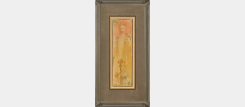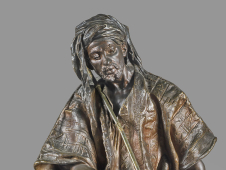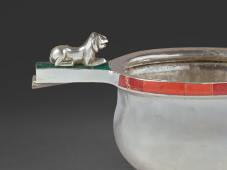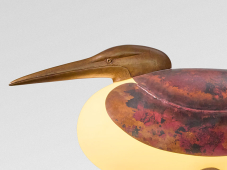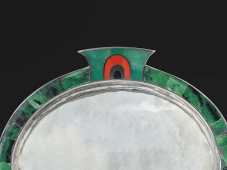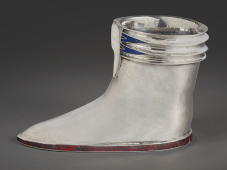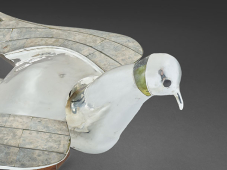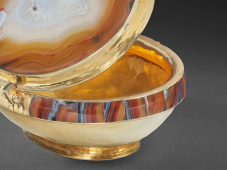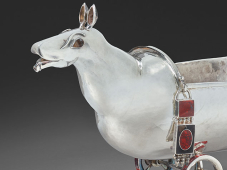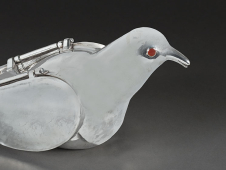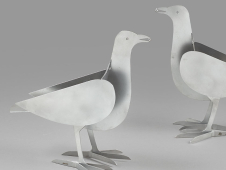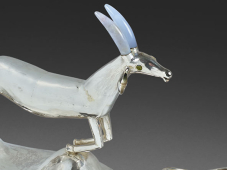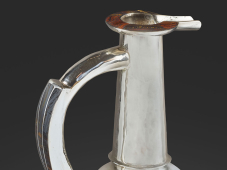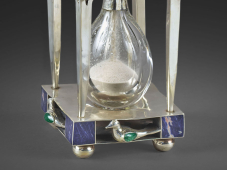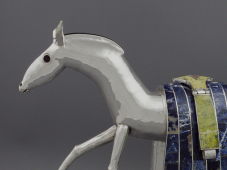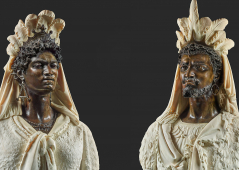Nemesia
Brussels, Musées royaux de Peinture, Les Aquarellistes, 1896, no. 88.
Description of the artwork
Executed by one of Belgium's most important Symbolist artists, this work on paper is one of the few examples of such accomplished watercolors by Fernand Khnopff to reappear on the art market.
This jeweled woman, with abundant red hair and an enigmatic face, is portrayed with branches of orange and white flowers in front of her. A later inscription on the reverse of the artist's cardboard gives further details of the iconographic theme: 'Nemésia. Allegorical fantasy inspired by a flower newly imported from the Congo at the end of the 19th century'. Nemesia is a species of flower native to southern Africa, where the famous English garden designer Sutton discovered it in 1892. It is one of the most beautiful newly-discovered flowers because of the luminosity and purity of its colors, which range from white to yellow, pink, salmon, orange and crimson.
Flowers returned to fashion in the nineteenth century, their popularity enhanced by industrial and commercial attention. The 1878 Paris Exposition Universelle had devoted an entire section to flower growing, both industrial and domestic. In the immense greenhouses of the Champs de Mars, Khnopff, like the writers Huysmans and Villiers de L'Isle-Adam, discovered the mysterious charms of the flower that Baudelaire had intimately associated with evil. Among the attractions, we should also mention the greenhouse run by M. Linden, a gardener from Ghent of international renown whose rare species imported from Latin America aroused the enthusiasm of both the public and specialists. The same Linden had founded in the magazine L'Illustration Horticole in 1854, which, until 1896, informed its readers of rare species, of the hidden meanings of different plants, and of their specific features. The review also provided a rich repertory of symbolic motifs that Khnopff was to draw on, in particular for his representation of vengeance in our pastel Némésia (1895). According to Draguet, « here the woman no longer plays with the flower as an emblem, she has become its allegorical incarnation. »
Our pastel might be a research on Stéphane Mallarmé's 1892 poem En écoutant les fleurs. Khnopff produced the frontispiece, and the final drawing shows a number of similarities with Nemesia: the long framing, and a full-length woman with flowing hair framed by a multitude of flowers.
Within Khnopff's graphic corpus, another parallel can be drawn with this unfinished canvas, drawn in charcoal and painted in oil around 1910, fifteen years after Némésia, and entitled Chimère, now in the Musée d'Ixelles. It shows exactly the same woman, also holding a jewel in both hands and about to tie it around her neck.
Dedicating almost all his art to the representation of women, Fernand Khnopff here depicts Elsie Maquet. It was through his familiarity with the British community in Brussels that Khnopff met the Maquet family, who were of Scottish origins and lived in the quartier Léopold of the city. The pale skin, long hair and striking eyes of the three Maquet daughters – Elsie, Lily and Nancy – epitomised the artist’s ideal of feminine beauty. From 1891 onwards, following the marriage of his sister Marguerite the previous year and her subsequent move to Liège, Khnopff often used the three Maquet sisters as models.
The present artwork is likely to be a portrait of Elsie, the eldest Maquet daughter, who was born in Glasgow in 1868. With her long red hair, Elsie Maquet posed for several significant paintings and drawings by Khnopff. These include two works inspired by a poem by the English poet Christina Rossetti; the painting I Lock the Door Upon Myself, today in the Neue Pinakothek in Munich, and the finished pastel drawing Who Shall Deliver Me? (fig.1) in a private collection; both works were completed in 1891. Elsie Maquet also served as the model for the painting A Blue Wing of 1894, today in a private Belgian collection.
The faces of the women depicted in these work exhibit a trancelike aspect, and in several instances the artist has added touches of blue chalk to emphasize the subject’s eyes. The portraits finished in this technique enchant with their fineness and the musicality of the lines. The facial features of the women appear like gossamer on the paper. The fragility of these faces has something seductive about it.
It was also at about this time that Khnopff developed a characteristic composition for many of his paintings and drawings of women, in which the model’s head is cut off at the top and/or sides by the edges of the paper or canvas, or by a framing device, and placed close to the picture plane, so as to focus the viewer’s attention on the face. This emphasis on a woman’s face also suggested a mask - a central motif of Symbolist art – behind which was hidden the true nature of the subject.
Geneviève Monnier’s remarks on Khnopff’s use of pastel and coloured chalks, either separately or in combination, may be seen as particularly apposite in the example of this striking drawing. As she writes, ‘Coloured crayons offered a more precise, more delicate medium, the paler colours calling for a more meticulous treatment, while pastel offered greater intensity in terms of line, colour and grain. In fact, one of the characteristics of Khnopff’s work is this special grainy texture in the colouring medium, obtained without making use of the grain of the paper surface as Seurat did in his drawings. His method resembled pointillism, the pastel strokes just touching the paper. Khnopff’s colour schemes often play on melancholy harmonies of white, grey and mauve. His faces are very pale, almost bloodless; they belong to creatures with reddish hair and strange-coloured eyes (like icy water or crystalline rock), wandering in another world, a world beyond the mirror.’
Origin
Marquis de Grammont, Paris (according to R. Delevoy).
Bernard de Grammont, Paris (according to R. Delevoy).
Private collection, Paris.
Literature
G. Deltour, Fernand Khnopff, in La Belgique d'Aujourd'hui, Berlin-Charlottenburg, n. d.
E. Louis, 'Les Expositions. Le Salon des Aquarellistes', in La Fédération Artistique, Brussels, November 29, 1896, no. 50.
L. Dumont-Wilden, Fernand Khnopff, Bruxelles, 1907, p. 72.
Fernand Khnopff' in Notices Biographiques et Bibliographiques concernant les Membres, les Correspondants et les Associés. 1907 - 1909, Bruxelles, Académie Royale de Belgique, 1909, p. 754.
M. Biermé, Les Artistes de la Pensée et du Sentiment, Brussels, 1925, p. 3.
J. Delville, 'Notice sur Fernand Khnopff', in Annuaire de l'Académie Royale des Sciences, des Lettres et des Beaux-Arts de Belgique, Brussels, 1925, p. 25.
R. L. Delevoy, C. de Croës, G. Olliinger-Zinque,
Fernand Khnopff, Brussels, 1987, no. 256, ill.
M. Draguet, Portrait of Jeanne Kéfer, Los Angeles, 2004, p. 75, fig. 68.
M. Draguet, Fernand Khnopff, cat. exp. Paris, Petit Palais, 2018, no. 96, ill.
75008 Paris, France
Saturdays from 2 to 7 p.m.








